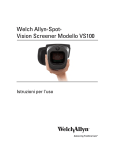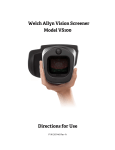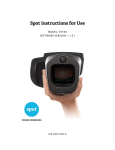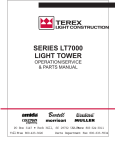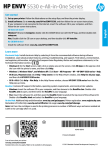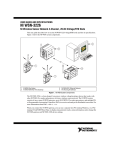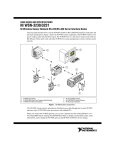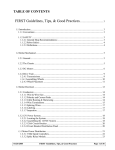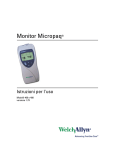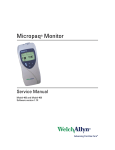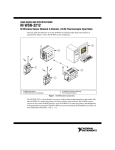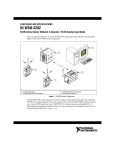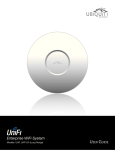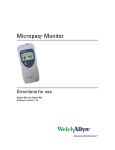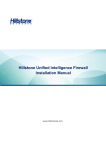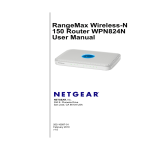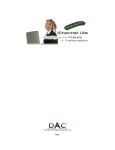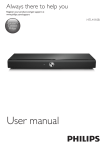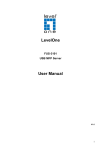Download VS100 Vision Screener, User Manual
Transcript
® ® Welch Allyn Spot Vision Screener Model VS100 Directions for use ii Welch Allyn Spot Vision Screener VS100 © 2015 Welch Allyn. All rights are reserved. To support the intended use of the product described in this publication, the purchaser of the product is permitted to copy this publication, for internal distribution only, from the media provided by Welch Allyn. No other use, reproduction, or distribution of the publication, or any part of it, is permitted without written permission from Welch Allyn. Welch Allyn assumes no responsibility for any injury to anyone, or for any illegal or improper use of the product, that may result from failure to use this product in accordance with the instructions, cautions, warnings, or statement of intended use published in this manual. Welch Allyn® and Spot® are registered trademarks of Welch Allyn. Software in this product is Copyright 2015 Welch Allyn or its vendors. All rights are reserved. The software is protected by United States of America copyright laws and international treaty provisions applicable worldwide. Under such laws, the licensee is entitled to use the copy of the software incorporated with this instrument as intended in the operation of the product in which it is embedded. The software may not be copied, decompiled, reverse-engineered, disassembled, or otherwise reduced to human-perceivable form. This is not a sale of the software or any copy of the software; all right, title, and ownership of the software remain with Welch Allyn or its vendors. This product may contain "free" or "open source" software (FOSS). To learn more about Welch Allyn's use and support of FOSS, please visit http://www.welchallyn.com/opensource. For patent information, please visit www.welchallyn.com/patents. For information about any Welch Allyn product, contact Welch Allyn Technical Support: www.welchallyn.com/about/company/locations.htm. DIR 80020275 Ver. A Revision date: 2015-04 This manual applies to Welch Allyn, Inc. 4341 State Street Road Skaneateles Falls, NY 13153 USA Regulatory Affairs Representative Welch Allyn Limited Navan Business Park Dublin Road Navan, County Meath, Republic of Ireland 901029 Vision Screener. 1 1 Introduction This Directions for use manual is a comprehensive guide designed to help you understand the capabilities and operation of your Spot Vision Screener VS100. The information in this manual includes all options available with the Spot Vision Screener. The applicability of some sections of this manual depends on the configuration of your particular device. Read this manual thoroughly before attempting to use the device. The vision screener is a hand-held instrument with a video display on the rear of the unit that provides subject visualization and alignment. Video display also provides user interface functionality for data input and display. The vision screener provides visual and audible cues to attract subject’s attention and gaze. The device provides a fast data collect for easy evaluation of the most difficult pediatric subjects of limited compliance. Each evaluation provides simultaneous binocular assessment of the subject’s refraction, pupil size and gaze. Intended use The Spot Vision screener is intended to measure the refractive power of the eye by measuring light reflexes from the retina. It also estimates pupil size, pupil distance and eye gaze deviation. It is intended for use on subjects six months of age through adults. Indications for use The Spot Vision screener is indicated for use by healthcare professionals or under the direction of a healthcare professional to screen or evaluate individuals for potential refractive errors associated with poor vision. Contraindications The Spot Vision Screener has no known contraindications. 2 Introduction Welch Allyn Spot Vision Screener VS100 Symbols Documentation symbols Consult operating instructions/directions for use (DFU). A copy of the DFU is available on this website. A printed copy of the DFU can be ordered from Welch Allyn for delivery within 7 calendar days. WARNING The warning statements in this manual identify conditions or practices that could lead to loss of data, illness, injury, or death. CAUTION The caution statements in this manual identify conditions or practices that could result in damage to the equipment or other property. Power symbols Rated power input, DC Battery inside (Not user replaceable) Power On/Off USB port DC power input port, Center pin positive Miscellaneous symbols Equipment is not protected against the ingress of liquid IPXØ Non-ionizing electromagnetic radiation This symbol is applicable for EC member countries only. To avoid potential negative consequences for the environment and possibly human health, this instrument should be disposed of (i) for EU member countries - in accordance with WEEE (Directive on Waste Electrical and Electronic Equipment) or (ii) for all other countries, in accordance with local disposal and recycling laws. Directions for use Introduction 3 The CE mark on this product indicates that it has been tested to and conforms with the provisions noted within the 93/42/ EEC Medical Device Directive. User Interface Symbols Battery status/level indicator Battery charging (Flashing) or charged (Continuous) Wireless On/Off button Connected to the wireless network No wireless network in range No IP address assigned by the router IP Unknown network ? 4 Introduction Welch Allyn Spot Vision Screener VS100 Cannot connect to configured network ! Sound off Sound on Continue Back Exit Print job in progress Directions for use Introduction 5 Warnings, cautions and notes WARNING The warning statements in this manual identify conditions or practices that could lead to loss of data, illness, injury, or death. CAUTION The caution statements in this manual identify conditions or practices that could result in damage to the equipment or other property. WARNING Risk of electric shock. All signal input and output (SIP/SOP) connectors are intended for connection of only other medical devices, medical systems or non-medical devices complying with IEC 60601-1, or other IEC standards appropriate to the device. For example, a printer connected via USB must comply with IEC 60950. Connecting additional unapproved devices to the device might increase chassis or patient leakage currents. WARNING Risk of electric shock. No modification of this equipment is allowed. WARNING Risk of electric shock. Do not open the device or attempt repairs. The device has no user-serviceable internal parts. Only perform routine cleaning and maintenance procedures specifically described in this manual. Inspection and servicing of internal parts shall only be performed by qualified service personnel. Attempt to modify this device may result in bodily harm and will void product warranty. WARNING Risk of electric shock. Do not allow the patient to make contact with accessible conductive parts (DC adaptor output connector, power input connector and USB port). Additionally, you should not make contact with the patient and any accessible conductive parts at the same time. WARNING To avoid a possible explosion, do not use the device in the presence of flammable anesthetics: mixtures containing air, oxygen, or nitrous oxide. WARNING Risk of data loss. If a reboot is required during a system freeze, data loss, such as printer configuration and subject data, can occur. WARNING Lithium ion battery. Risk of fire, explosion, and burns. Do not handle or disassemble the battery pack. WARNING Use only accessories approved by Welch Allyn. Visit www.welchallyn.com. The use of any other accessories can result in inaccurate patient data, can damage the equipment, and can void your product warranty. WARNING Injury risk and equipment damage risk. When charging the device, properly secure all DC transformer cords to minimize trip hazards. WARNING Patient injury risk. Verify patient identity on the device after manual or barcode entry and before printing or transferring patient records. WARNING False positive and false negative results may occur in a healthcare screening. Vision screening does not replace a complete eye examination by an ophthalmologist or optometrist. 6 Introduction Welch Allyn Spot Vision Screener VS100 Caution The device is a precision instrument. Do not subject it to physical shock. Caution Do not use the wrist strap as a means to carry the device; it is not designed to carry the weight of the device. Caution The device is not waterproof. If you accidentally drop it into liquid or liquid is spilled on the device, contact Welch Allyn Technical Support immediately. If minor water droplets are found on the device, wipe off with a soft dry cloth. Caution Do not store the device in the foam or case while the DC power adapter is plugged in; this may cause damage to the power cord and to the device. Caution Do not leave the device in excessive heat or in direct sunlight. High temperatures can cause the device to malfunction. Caution When plugging the DC power connector into the device, do not force the power connector into the device; this may cause damage to the device, which will not be covered under warranty. Caution Do not push or scratch the touchscreen display with stiff or rigid objects. This may cause damage to the device. A stylus is acceptable for use with the device. Note A minimum pupil size of 4mm is required for screening to occur and may be difficult to achieve in a room with any light source. If the pupils are too small, the vision screener will notify you on screen to adjust the lighting in the room. For best results, subject’s pupils should be 5mm or greater. Directions for use Introduction 7 Contents Checklist The main shipping box contains the vision screener, Directions for use, and the Accessory box. The Accessory box contains: AC Power Cord. Power Supply/Charger. Cleaning Cloth. Velcro Cable Straps. Note Please do not discard the box and foam. Damages incurred by shipping the device in non-approved packing material will void the limited warranty (see warranty for details). If you purchased a carrying case, place the foam from the shipping box inside the carrying case for safer transport. Do not store your vision screener in the foam or case while the Power cord is plugged in. 8 Introduction Welch Allyn Spot Vision Screener VS100 9 2 Controls, Display Window, and Connections Drawings and text are representative of the Spot Vision Screener with all available options. Features Rear View of Vision Screener 1 LCD Screen 2 Neck Strap Mount 3 AC Power Connector 4 Power Button 5 Wrist Strap Mount 6 Serial Number Label 7 Tripod Mount 8 Battery Charge Green LED Indicator 9 USB Port 10 Ambient Light Sensor 10 Controls, Display Window, and Connections Welch Allyn Spot Vision Screener Front View of Vision Screener 1 Range Finder 2 Front Glass 3 Speaker Directions for use Controls, Display Window, and Connections 11 Display Window When the vision screener is powered on, the main menu or Home Screen will appear. If the vision screener is connected to a network, the network name and IP address will be visible in the upper left corner in the black bar. 1. Age Range To begin instant screening, with no personal subject data, select an age range of the subject from the Home screen. You will be able to enter subject data after the screening if desired. 2. Start Button The Start button will allow you to: • Enter subject information such as ID, First and Last Name, Gender and Date of Birth (DOB)/Age (Required) • Find queued subjects (exact match on the ID screen) • Begin the screening process (Binocular and Monocular available) • Review and print screening results 3. Icons on Bottom of Screen • Queue – View, select or search for queued subjects from a list to begin the screening process. • History – View already screened subjects (completed records). • Tools – A variety of options to customize the vision screener. 12 Controls, Display Window, and Connections Welch Allyn Spot Vision Screener Subject Information Screen On the subject information screen, confirm all data is correct. You can modify information by touching the field you wish to change. After the change is completed select OK and you will come back to the subject information screen. Date of Birth/Age is required and will highlight in red if there is no age or if it is not a valid birthdate or age (under 6 months). Select GO to begin the screening process. Directions for use Controls, Display Window, and Connections Understanding the Results 1 Pupillary Distance 2 Pupil Size Indicator 3 Right Eye (OD), Left Eye (OS) 4 Complete refraction SE - Spherical equivalent DS - Sphere DC – Cylinder Axis – Axis 5 Screening Result 6 Home 7 Cylinder Convention 8 Alignment Indicator 9 Degree, Horizontal, Vertical 13 14 Controls, Display Window, and Connections Welch Allyn Spot Vision Screener Tools The Tools menu will allow you to customize and configure the vision screener with the following options: Displays firmware version, software application version and serial number. Also displayed is a quick reference of important the vision screener features, including memory storage levels of the device View the age-based criteria settings used for exam recommendations that are currently active on the vision screener. Allows you to set the current date and time for your vision screener. Enables you to import and export using an inserted USB storage device. Location allows you to set a location for a screening and all subjects will be tied to that location. Allows you to connect the vision screener to a wireless network. You can manually enter your network name (SSID), select the security type, and enter the passphrase for your network. From this page you can view and change your TCP/IP settings. Allows you to configure a network printer and print a test page. It also lets you view printer status. Allows you to configure how data is displayed on the Results screen when a screening is complete. This includes data format, cylinder convention, displaying or hiding measurements and recommendations, setting default screening display and screening Helps you set a security PIN for your device for added security. If enabled a PIN will be required whenever you start the device or upon waking it. Activates the license on the device. Allows you to select the language that will display on the vision screener. 15 3 Setting up the Vision Screener Charging 1. Connect the provided DC cord set and power supply/charger together. 2. Gently lift the back of the vision screener to view the available connections. 3. Locate the DC power connector on the vision screener and connect the power supply/charger. The DC power connector on the power supply/charger will easily insert into the DC power connector on the vision screener. Using force to connect the power charger can damage the device and will void the warranty. 4. Plug the DC power cord into an available wall outlet to charge the device. Powering the vision screener on and off 1. To turn the vision screener on, press and release the power button (start-up process takes approximately 30 seconds). Once powered on, you will see the Main Menu 2. To turn the device off, press and hold power button for two seconds. A confirmation screen will appear to confirm shut down. 3. A flashing green light means the unit is charging, a steady green light means the unit is fully charged. Tripod Mount The vision screener can be mounted to a standard photographic tripod. A ¼-20 threaded mount located on the bottom of the device is available for attaching a tripod. Helpful Hints • No activity on the vision screener—After 60 seconds the screen will dim; after 5 minutes the screen will automatically turn black to conserve battery power. Tap the screen to ‘wake up’ the vision screener or press the power button. If the screen does not light up, plug in the power cord and try again. • Exporting/Clear All—Verify you have successfully exported desired data to a USB drive before you select Clear All. • Routinely delete ALL records from the vision screener—Go to the History screen and select Clear All icon. Select Delete All Records. You may also delete all queued records. • Avoid powering off during a screening—Once the screening takes place, exit by selecting the Exit button, then power down the device normally. 16 Setting up the Vision Screener Welch Allyn Spot Vision Screener • Input Screen—Holding down the Back button on any input (keyboard) screen will delete all data from the field. • Low Battery—When the battery level reaches a very low level, a notice will appear to the User indicating they should insert the power cable or the device will shut down. If no power cable is inserted, the device will automatically shut down due to low voltage Wireless Network Configuration From the Tools menu, select the Network icon. Current network settings are displayed on the screen. To add or edit any of the fields, see instructions below. If they are correct, select OK to be returned to the Tools menu. To add/change the network name (SSID): 1. Touch the SSID Name field; a keyboard will appear. 2. Enter the SSID (case sensitive); select OK to save your changes and return to the previous screen. The OK button will turn dark when changes have been made and are available to be saved. To add/select the security type: Select the appropriate security type: None, WEP, or WPA. Note WPA option supports WPA Personal/WPA2 Personal. To add/change the passphrase (password): 1. Touch the Passphrase button; a keyboard will appear (this is only available when the security field is set to WEP or WPA). 2. Enter the passphrase (case sensitive) and select OK. 3. On the Network screen, select OK to save changes, otherwise changes will not be applied. To enable or disable the wireless capabilities on the vision screener: Select the On/Off button on the network menu. Note Wireless must be on for printing to be enabled. To view advanced network settings: 1. Select TCP/IP. From here, you can also view your current TCP/IP address as assigned by your network. 2. For additional network configurations, select Static to manually configure your network address and settings. (Also available is the MAC address of your vision screener). Directions for use Setting up the Vision Screener 17 Printer Configuration The vision screener is capable of connecting and printing to most network capable Hewlett-Packard (HP) printers. The vision screener also contains some generic PCL drivers that can be used with non-HP printers, as well as a custom driver that supports the Brother QL-720NW label printer. Note 1. In order to install the QL-720NW on the vision screener, it must have QL-720 in its name on the network and you must select the driver labeled QL-720NW from the driver list. Use Brother DK2205 Continuous Length Paper Tape or equivalent. From the Tools menu, select the printer icon. 2. The next screen will list the available printers on the vision screener. This is a list of all printers already added to the vision screener. To select or change a default printer: From the printer list, find and select the desired printer (it will auto-highlight in blue.) If more than one printer is listed, touch Set as Default button for the highlighted printer. To configure a printer Select a printer then press the Edit button to view printer status or print a test page. To delete a printer 1. Select the printer from the available printer list; touch the minus button to delete. 2. A pop-up will appear asking you to confirm deletion of the printer. To reset the printer system This will delete all printers: 1. Touch the Trashcan icon. 2. A pop-up will appear; select Delete. This will remove all current printer configurations. Adding a network printer 1. From the Printers Available screen, select the plus sign to add a printer. 2. If any printers are found on the network, they will appear in the list. If your printer is not shown, select + Add New Printer at the top of the screen or you can select the printer you wish to add then press the continue icon. Note Make sure you are connected to a wireless network with available printers for the vision screener to show printers available. 3. Review the printer details (Name, Driver and Location). To change or add settings touch the field you wish to change. If you need to add a driver, you can use the search feature by typing part of the driver name in the Search field. 18 Setting up the Vision Screener Note Welch Allyn Spot Vision Screener PCL drivers are available for non-HP printers. It is not guaranteed that every printer will work with the vision screener. 4. Once changes have been made, select Save. 5. Once saved, the Print Test Page will appear dark. 6. A printer icon will appear in the menu bar indicating the job is processing. The number of jobs in the print queue will show up in the Jobs box at the top of the Printer Details screen, along with the current printer status. Note 7. If you are having a problem with your printer or a print job is stuck in the queue, select the reset button to clear the print job and reset the printer. Return to the Printers Available screen and be sure to highlight the desired installed printer and set is as the default by selecting the Set as Default button. Adding a Direct Connect (USB) Printer 1. Connect the Vision Screener to a wireless network. 2. Connect the USB cable from the printer to the VS100’s USB port. 3. Note the IP address of the VS100 from the main menu. 4. Visit the following URL on a computer on the same network: http://<ip_address_of_VS100>:631/ 5. Click on the Administration tab; under Printers, click on the Find New Printer button. 6. Click Add This Printer on the one listed with USB in the title, for example: HP ENVY 5530 series (HP ENVY 5530 series USB CN3C91S1N205XT HPLIP). Note 7. Give the printer a simpler name for ease of typing on the VS100, for example: use ENVY5530 instead of HP_ENVY_5530_series_USB_CN3C91S1N205XT_HPLIP. Click Continue. 8. Choose Make and click Continue, for example: HP. 9. Choose Model and click Add Printer, for example: HP Envy 5530 Series hpijs, 3.13.9 (en, en). 10. Click Set Default Options. 11. On the VS100, press Tools, then choose Printer. 12. Press the + arrow to add a new printer, then press the right arrow to choose Add New Printer. 13. Give the printer a name, for example: HP Envy 5530. 14. Press Edit under Driver, choose the proper driver for the printer. 15. Press Edit under Location, type in ipp://127.0.0.1/printers/<printer_name>, for example: ipp://127.0.0.1/printers/ENVY5530. 16. Press the Save button. 17. You may now press the Print Test Page button to confirm everything works. Directions for use Setting up the Vision Screener 19 Importing/Exporting Files 1. From the Tools menu, select Import/Export and you will be directed to the Import/ Export screen. 2. Insert a USB storage device into the USB port on the vision screener (Recommended USB size is 8GB or larger). 3. Once the USB device is detected, the Import and Export buttons will be available for selection and you will see the USB symbol in the upper right black bar next to the date. 4. The Import button will only become available if the vision screener recognizes a valid import file. Number of import files found will be shown on the screen. Note If the buttons do not highlight within five seconds of inserting the USB drive, remove the USB, insert it into your PC and remove all files from the drive before attempting to retry. Export 1. Select the Export button. If you wish to export one file containing no subject specific data select Exclude Personal Data, If you do not choose this option, then all data will be exported. Select Export button again to begin the export process. 2. Wait until the message “Export Finished successfully” displays, select OK then you may safely remove the USB drive from the vision screener. 3. The exported folder name on the USB will be “Spot_SerialNumber_YYYYMMDD_HHMMSS” (the folder labeled “Spot_SerialNumber” will only contain screening data if inserted while screening subjects). It will contain: Note • Spot Criteria file (located in the “import” folder). • Spot Subjects Template file (located in the “db” folder). • Spot Results file (located in the “db” folder). • Spot Banner file (located in the “import” folder, will only be visible if custom banner was added). • Subject PDF files (located in the “pdf” folder). If the USB drive is removed prior to export completion, data transfer may be incomplete or become corrupted as a result. 20 Setting up the Vision Screener Welch Allyn Spot Vision Screener Import With the import function, you can import: • Updated criteria files (SpotCriteria.csv) • Future, queued, screening files (SpotSubjects.csv or Location.csv By using a Location in the name of the file, this will default all subjects in the file to a location via the name of the file, ex LakeMary.csv would default to “LakeMary” as the location for all subjects in this file) • Custom banner for the screening reports (banner.png) The file must follow the correct naming convention for a successful import (i.e., banner.png, SpotCriteria.csv, SpotSubjects.csv. Remember SpotSubjects can have a location as the name of the file). • Updated criteria files (SpotCriteria.csv) Custom Banner Welch Allyn offers the ability to add a custom banner to the bottom of the printable reports. Please note that Welch Allyn does not supply custom banners. You will need to create your banner using the specifics below: • Banner files must be named “banner.png” • No larger than 1MB • Image must be 1376 x 240 pixels To add a custom banner 1. Place the banner.png file on the root/top-level directory of the USB. 2. Insert the USB in the vision screener. Go to Tools, then select Import/Export. 3. The import file option will highlight; select Import. 4. To verify that the file was imported successfully, screen a new subject or select a completed record and print the report. Your new banner will be printed on the bottom of the report. Directions for use Setting up the Vision Screener 21 Web Access When connected to a wireless network, the vision screener gives you the ability to view files from a web browser (Internet Explorer, Firefox, Safari, etc.) on a PC on the same network. To access the webserver on the vision screener: 1. From your computer, open a web browser; enter the devices IP address in the address bar (this is located on the top black bar on the Home Screen). 2. You will be prompted to enter the username and password. Username: spot Password: 0000 Note If you have enabled security on your device, the password will be your four-digit pin code. 3. Default will go to the Report folder. This contains the pdf folder where you can find subject PDF files. 4. To view the SpotResults.csv file change to the “db” directory. Licensing In order to use the screening functionality of the vision screener, the device needs to be licensed. If your device came new from the factory with this instruction document, your license is already installed and active. If you have updated the software on your device, the licensing will need to be updated as follows: 1. Connect an empty USB device to the vision screener USB port. 2. Go to Tools, then press the License button. 3. After a moment, a dialog box will appear indicating that the registration file has been exported to the USB drive. 4. Send the file titled spot-[serial number].reg to Welch Allyn Support at [email protected]. Welch Allyn Support will review your registration file and email you a valid license key. Once you receive the key, perform the following: 1. Save the file to the top level (root directory) of a USB Drive. 2. Insert the USB drive into the USB port on the vision screener. 3. From the Tools menu, select License. After a moment, a dialog box will appear indicating that the license file has been imported onto the device. 22 Setting up the Vision Screener Welch Allyn Spot Vision Screener 23 4 Vision Screener Operation Screening Environment For optimal screening results, screen in an environment with lower level subdued lighting. Be sure to eliminate or block any sources of sunlight and/or incandescent light from reflecting on the subject’s eyes. Florescent light is acceptable but note that the subject’s pupil size can be affected and can decrease your chances of a successful screening. Note A minimum pupil size of 4mm is required for screening to occur and may be difficult to achieve in a room with any light source. If the pupils are too small, the vision screener will notify you on screen to adjust the lighting in the room. For best results, subject’s pupils should be 5mm or greater. Screening a Subject 1. Position yourself approximately 1 meter from the subject. If using a tripod, place the tripod approximately 1 meter from subject. 2. Start screening and slowly rotate the device upward to meet both of the subject’s eyes. Adjust your distance from the subject until both eyes are clear on the screen. With a tripod, adjust the tripods position up or down and side to side until the subjects eyes are in focus on the screen. A blue screen indicates you are too close or too far from the subject. Note Keeping the vision screener even (on axis) with the subject’s eyes will promote quicker results and help ensure you are not capturing other objects. Position yourself with one foot in front of the other, slowly rock forward and back until the screen turns grey, indicating you are in the capture range. When using a tripod, move the tripod as needed to ensure focus on the subject’s pupils until the screen turns grey. 3. Keep the vision screener device steady until the screening wheel appears, indicating the capture process is underway. 4. If you were unable to capture the subject’s pupils with a successful screening, the measurement will be stopped, at this point you can retry, flag the record, try monocular mode or return to the Home screen. 5. If the pupils are too small, the device will notify you on screen to adjust the lighting in the room to promote larger pupil size. 24 Vision Screener Operation Welch Allyn Spot Vision Screener How to Focus the vision screener A Position vision screener approximately 36 inches away from subject. B Hold vision screener close to body and lean forward and backward until the screen becomes gray. C Make small movements until the spinner appears on the gray screen. Note Eyes should be wide open and kept on the center of the frame for best results. Directions for Use Vision Screener Operation 25 Monocular Mode In monocular mode, you will be given the option to choose which eye to screen. This should be attempted when binocular screening does not capture the subjects’ pupils. 1. Touch the side of the screen that corresponds with the eye you would like to screen. (OD = subjects right eye; OS = subjects left eye). 2. When complete, you can repeat the process with the other eye by choosing Mono from the Results Options Menu. Viewing the Results The results screen will appear at the end of the screening process. All results viewing options are in the Tools menu under Results including; defaulting to a summary screen or the detailed results screen, hiding recommendations or measurements, cylinder convention options and raw or rounded data. 26 Vision Screener Operation Welch Allyn Spot Vision Screener Understanding the Results The figure below outlines the results screen and what it shows you: 1 Pupillary Distance 2 Pupil Size Indicator 3 Right Eye (OD), Left Eye (OS) 4 Complete refraction SE - Spherical equivalent DS - Sphere DC – Cylinder Axis – Axis 5 Screening Result 6 Home 7 Cylinder Convention 8 Alignment Indicator 9 Degree, Horizontal, Vertical Results that are out-of-range are indicated in red. Note Screening results provide an output that is either in- or out-of-range, accompanied by the appropriate statement in the device output display (“Screening Complete” or “Complete Eye Exam Recommended”). The displayed message is intended to prompt the caregiver to assess whether the subject should be referred to an eye care specialist for further evaluation or simply be monitored at future screenings. Directions for Use Vision Screener Operation 27 Vision Screener Criteria To modify current screening criteria: 1. Perform an export and insert the USB drive into your PC. 2. Go to the USB drive folder and open the Spot folder that you just exported; select the import folder. 3. Copy the file “SpotCriteria.csv” to the top folder on the USB drive (the file cannot be within a folder). Once copied, open the file. 4. Make any desired changes using Microsoft Excel or compatible program. 5. Save file as a Comma Separated Value (.csv) file. You must make sure the file is called “SpotCriteria.csv”. Eject the USB drive from your PC and insert into the vision screener. 6. Go to the Tools menu and select Import/Export. Select the Import button to import the updated criteria file. 7. To verify the file was imported successfully, go to the Tools menu and select Criteria; review new settings. Note When custom criteria has been imported and is in use, there will also be a Restore button at the bottom of the screen. This button will prompt the user to confirm they want to revert to the default criteria that was shipped with the device. By confirming, the custom criteria will be deleted from the vision screener and replaced with the default criteria. Subjects The vision screener gives you the ability to populate a subject list for queued subjects. 1. Perform an export, once complete, remove the USB drive from the vision screener and insert it into your PC. 2. Select the Spot folder that was just created. 3. Select the “db” folder, then select the “SpotSubjects.csv” file. 4. The SpotSubjects.csv file contains six columns; do not change any of the column headings. Simply add information to the columns as shown below: Note You may add a column before the Patient ID column and call it Location if you need to create specific locations for each subject. • Patient ID—You can use any combination of alpha, numeric characters and symbols. This field is used for quick subject look-ups. • First Name—Enter the first name. Use any combination of alpha characters. • Last Name—Enter the last name. Use any combination of alpha characters. • Date of Birth—Enter the date of birth in the format MM/DD/YYYY. You can enter the age of subject in years, months or a combination of both. This field is required for the import to work. 28 Vision Screener Operation Welch Allyn Spot Vision Screener For example: If a subject were 2 years and 10 months old, you would enter 2Y10M. Use numeric and alpha characters. • Gender—Select Male or enter M; select Female or enter F. Alpha characters only; leaving the field blank will default to no gender identified. • Eyewear prescription—Select None, Glasses, or Contacts. By leaving the field blank, ‘None’ will be set as the default. After updating the import file: 1. Confirm the file is saved as a Comma Separated Values (.csv) file. 2. Verify file name is ‘SpotSubjects.csv’ or ‘DesiredLocation.csv’. Note If labeling your subject file(s) with a location, the vision screener will import all files found on the USB drive at the same time 3. Follow the import procedures to load the file onto the vision screener. To verify the file was imported successfully: Return to the Home screen and go to the Queue icon to view the new records. 29 5 Troubleshooting System Restart 1. To power cycle the vision screener - press and hold the On/Off button until a confirmation screen appears. Select Confirm to power off. 2. When the screen turns black, wait 30 seconds and then press the power button to turn the vision screener back on. Ensure the device has power by plugging in the power cord. System Freeze In the event the vision screener locks up and is unresponsive to touch, you will need to perform a hard system reset. 1. Press the On/Off button. 2. If the Power Off window appears, select Confirm to shutdown the device. 3. If not, press and hold the On/Off button until the screen goes black, then release the On/Off button. 4. Wait about one minute then perform the normal start-up process. Note This may cause some data loss (ex. printer configuration and subject data). Printer Issues Check that your printer is turned on and has sufficient ink or toner: 1. Print a test print page directly from the printer. 2. After you confirm your printer is in proper working order, verify the printer is on a local network by printing to the printer from a PC on the same local network. 3. If all of the above are in working order perform a System Restart (see above). Wireless Issues If you encounter problems connecting to a wireless network: 1. Check for the Wireless icon in the upper right corner. If the icon is red, try power cycling the vision screener first. 2. Verify all network settings are entered correctly. 3. If the settings are correct, try turning the vision screener off, then back on. 30 Troubleshooting Welch Allyn Spot Vision Screener 4. Check on the Home screen to see if your network name and IP address is identified in the upper left corner in the black bar. Note Restarting helps to reinstate the connection to the network. 5. If the connection does not automatically reconnect, go to Tools, Network, select Security Type, reselect the correct type (None, WEP, WPA) then select the highlighted OK. This should re-instate the network connection. System Messages Specific system messages may appear while operating the vision screener. If so, the information below will assist you in identifying what the messages indicate: Message Text Message Actions Sorry for the inconvenience. We OK or need to reboot the device. Cancel Meaning Action Screening mode has encountered a problem and the device needs to be restarted. Problem encountered. The device needs to reboot. Reboot The system was not able to start and has attempted to correct the issue. Select Continue to reboot the device or Cancel to continue using the device in Read Only mode. If the problem persists, contact Welch Allyn Support. Select Reboot and try again. If problem persists, contact Welch Allyn Support. The screening system is not available. None The Exam system did not initialize, or is unresponsive. Power cycle the device and try again. If problem persists, contact Welch Allyn Support. The screening system is not initialized. None The Exam system did not initialize, or is unresponsive. Power cycle the device and try again. If problem persists, contact Welch Allyn Support. Device has not finished saving the previous screening. None The system has detected that it is still saving Power cycle the device and try again. If files to disk from a previous exam. problem persists, contact Welch Allyn Support. Un-calibrated device None The system has not been able to read the device configuration file. Power cycle the device. If problem persists, contact Welch Allyn Support. For more information on troubleshooting or error messages, contact Welch Allyn’s support team (refer to the last page of this manual for additional contact information). 31 6 Cleaning the Vision Screener Clean the Vision Screener WARNING Electric shock hazard. Before cleaning the monitor, disconnect the DC power cord from the power outlet and the vision screener. WARNING Liquids can damage electronics inside the vision screener. Prevent liquids from spilling on the vision screener. If liquids are spilled on the vision screener: 1. Power down the vision screener. 2. Disconnect the power plug. 3. Dry off excess liquid from the vision screener. If liquids possibly entered the vision screener, remove the vision screener from use until it has been properly dried, inspected, and tested by qualified service personnel. Clean on a routine basis according to your facility's protocols and standards or local regulations. If the vision screener is on, lock the display and disconnect the DC power cord. The following agents are compatible with the vision screener: • 70 percent isopropyl alcohol • 10 percent chlorine bleach solution Disinfect according to your facility's protocols and standards or local regulations. 70 percent isopropyl alcohol Wipe the vision screener with a clean cloth slightly dampened with 70 percent isopropyl alcohol. 10 percent chlorine bleach solution 1. Wipe the vision screener with a clean cloth slightly dampened with a 10 percent bleach and water solution. Follow the cleaning agent manufacturer's guidelines. 2. Rinse with a clean cloth slightly dampened with water that meets EP and USP quality standards. 3. Allow the vision screener surface to dry for a minimum of 10 minutes before using the monitor. 32 Cleaning the Vision Screener Welch Allyn Spot Vision Screener 33 7 Specifications The power supply/charger’s supplied with the vision screener have the following characteristics: • This vision screener DFU document is valid for software versions 3.0.xx.yy. • The Vision Screener has been calibrated as part of the manufacturing process and does not require calibration henceforth. • The external power supply/charger supplied is a Class II equipment and the vision screener is also a Class II equipment when connected to the external power supply/ charger. • The vision screener is internally powered by equipment (battery) when not connected to the external power supply/charger. • Protection against electric shock, no applied part. • The vision screener is rated IPX0 and thus not protected from the ingress of water. • The vision screener is not suitable for use in the presence of a flammable anesthetic mixture with air or with oxygen or nitrous oxide. • The vision screener is suitable for continuous operation. • The vision screener quickly and easily detects vision issues across all age groups starting at 6 months. • Welch Allyn suggests a battery replacement, at an appointed Welch Allyn repair facility, every 2.5 years at the owner’s expense. The vision screener regular maintenance consists of wiping dust or dirt off the front glass surface and the LCD display as needed. • The USB port shall only be used for software download/upload via a USB flash drive and shall not be cable connected to any other device. Specifications Mfg: SL Power Electronics Model: MENB1040A1503N01 or MEMB1040A1541N01 Input Voltage: 90 – 264VAC (100 – 240VAC Nominal) Input Frequency: 47 – 63 Hz Input Current: 100VAC: 1.1A Avg. Efficiency: 81-87% @ 0-50 W, ≥ 87% @ >51 to 250 Dimensions (cm/in): 21.6 cm x 17.1 cm x 12.1 cm (8 ½ in. x 6 ¾ in. x 4 ¾ in.) 34 Specifications Welch Allyn Spot Vision Screener Weight (lbs.): ~2.55 Wireless Network: 802.11 b/g/n Operating Temperatures (°C): +10 to +40 Operating Humidity: 30% to 95% Relative Humidity (non-condensing) Storage/Shipping Temperatures (°C): 0 to +50 Storage/Shipping Humidity: 0% to 95% Relative Humidity (non-condensing) Storage/Shipping Atmospheric Pressure: 800 hPA to 1060 hPA Expected Battery Life: 2.5 Years (Under Normal Usage) Measurements Note Screening results provide an output that is either in- or out-of-range, accompanied by the appropriate statement in the device output display (“Screening Complete or “Complete Eye Exam Recommended). The displayed message is intended to prompt the caregiver to assess whether the subject should be referred to an eye care specialist for further evaluation or simply be monitored at future screenings. Refraction Spherical Equivalent: • Range: -7.50D to +7.50D in 0.25D increments • Accuracy: -3.50D to 3.50D, ± 0.50D -7.50D to < -3.50D, ± 1.00D > 3.50D to 6.00D, ± 1.00D Cylindrical: • Range: 0.00D to +3.00D in 0.25D increments • Accuracy: 0.00D to 1.50D, ± 0.50D > 1.50D to 3.00D, ± 1.00D Cylindrical Axis: • Range: 1 to 180 degrees in 1-degree increments • Accuracy: ± 5 degrees (for cylinder values > 0.5D) Pupil size: • Range: 4.0 mm to 9.0 mm in 0.1 mm increments • Accuracy: ± 0.1mm Pupil distance: • Range: 35mm to 80 mm in 1 mm increments • Accuracy: ± 1 mm Time per measurement:1 s • Measuring distance: 1 m ± 5 cm • Fixation target:Random visual pattern and audible sound Measurement principle: Optical reflex Directions for Use Specifications 35 Environmental Protection This device contains Lithium ion cells and other electronic materials. Please contact your local government authorities for proper electronic waste recycling or disposal methods at end of life. EMC Information This equipment has been tested and found to comply with the limits for a Class B digital devices, pursuant to Part 15 of the FCC Rules. This medical device equipment is suitable for use in all commercial and domestic establishments. This equipment generates, uses, and can radiate radio frequency energy and, if not installed and used in accordance with the instruction manual, may cause harmful interference to radio communications. However, there is no guarantee that interference will not occur in a particular installation. If this equipment does cause harmful interference to radio or television reception, which can be determined by turning the equipment off and on, the user is encouraged to try to correct the interference by one or more of the following measures: • Reorient or relocate the receiving antenna. • Increase the separation between the equipment and receiver. • Connect the equipment into an outlet on a circuit different from that to which the receiver is connected. • Consult the dealer or an experienced radio/TV technician for help. The maximum wireless signal rate for the system is derived from IEEE Standard 802.11b/ g/n specifications. Actual data throughput will vary. Network conditions and environmental factors, including the volume of network traffic, building materials and construction, and network overhead, may lower actual data throughput rate. Environmental conditions will adversely affect wireless signal range. Electromagnetic Compatibility This product conforms to the EMC standard (IEC 60601-1). • MEDICAL ELECTRICAL EQUIPMENT needs special precautions regarding EMC and needs to be installed and put into service according to the EMC information provided in the accompanying documents. • Connectors should not be touched and connections should not be made to these connectors unless ESD precautionary procedures are used. • Portable and mobile RF communications equipment can effect medical electrical equipment. • The use of accessories and cables other than those supplied with the instrument exception for cables sold by the manufacturer of the equipment as replacement parts, may result in increase emission or decrease immunity of the equipment or system. • The equipment or system should not be used adjacent to or stacked with other equipment. If adjacent or stacked use is necessary, the equipment or system should be observed to verify normal operation in the configuration in which it will be used. 36 Specifications Welch Allyn Spot Vision Screener EMC Table Table 1. Emission Guidance The Welch Allyn vision screener is intended for use in the electromagnetic environment specified below. The operator or the user of the device should assure that it is used in such an environment. Emission Test Compliance Electromagnetic environment guide RF EmissionCispr 11 Group 1 The vision screener must emit electromagnetic energy in order to perform its intended function. Nearby electronic equipment may be affected. RF EmissionCispr 11 Class B Harmonic EmissionIEC 61000-3-2 Class B Compliant Compliant Voltage Fluctuation/flicker Emission IEC 61000-3-3 The vision screener is suitable for use in all establishments. Table 2. Immunity Guidance The vision screener is manufactured to work in the electromagnetic environment specified below. The operator or user should make sure it is used within those environmental conditions. Immunity Test Test level EN 60601-1-2 Conformity Level Electromagnetic environment guide Electrostatic ± 8kV air ± 8kV air The floor should be in wood, concrete or ceramic Discharge (ESD) EN ± 6kV contact ± 6kV contact tile. If the floor is covered with synthetic material, 61000-4-2 relative humidity should be at least 30%. Electrical Fast Transient/Burst EN 601000-4-4 Surge EN 61000-4-5 ±2 kV high voltage power line Differential mode: ±1 kV Common mode: ±2kV Voltage dips, short <5% UT (>95% dip of UT) interruptions and for 0,5 cycle voltage variations on 40% UT (>60% dip of UT) power supply input for 5 cycle lines EN 61000-4-11 70% UT (>30% dip of UT) for 25 cycle <5% UT (>95% dip of UT) for 5 seconds Magnetic field at 3 A /m power frequency EN 610004-8 ±2 kV high voltage power line The quality of the power supply should be that one of a typical commercial or clinical environment. Differential mode: ±1 kV Common mode: ±2kV <5% UT (>95% dip of UT) for 0,5 cycle 40% UT (>60% dip of UT) for 5 cycle 70% UT (>30% dip of UT) for 25 cycle <5% UT (>95% dip of UT) for 5 seconds 3 A /m The quality of the power supply should be that one of a typical commercial or clinical environment. The quality of the power supply should be that one of a typical commercial or clinical environment. If the user requests a continuous functioning during power supply interruptions, it is recommended a backup power supply unit (UPS) or battery. Power frequency magnetic fields should have characteristic levels of a typical commercial or clinical environment. Directions for Use Specifications Table 3. Immunity Radio Frequency Guidance The vision screener is manufactured to work in the electromagnetic environment specified below. The operator or user should make sure it is used within those environmental conditions. Immunity Test Test level EN 60601-1-2 Conformity Level Electromagnetic environment guide Conducted RF 3 Veff from 150kHz to 3 Veff from 150kHz to 80MHz The portable and mobile devices with RF EN 61000-4-6 80MHz communication shouldn’t be used near any part Radiated RF 3 V/m from 80MHz to 3 V/m from 80MHz to 2.5GHz of the device, including cables, except when they follow the recommended safety distance EN 61000-4-3 2.5GHz for separation, calculated with the equation Surge EN 61000-4-5 Differential mode: ±1 kV Differential mode: ±1 kV applicable to the frequency of the transmitter. Common mode: ±2kV Common mode: ±2kV Recommended safety distance for separation: D= 1.2 x P from 150kHz to 80MHz D= 1.2 x P from 80MHz to 800MHz D= 2.3 x P from 800MHz to 2,5GHz Where P is the nominal maximum power of the transmitter output expressed in Watts (W) as specified by the transmitter manufacturer and d is the recommended separation distance expressed in meters (m). The field intensity of the fixed RF transmitters, as checked in an electromagnetic investigation of the locus, should be less than the conformity level for each range of frequency. It is possible to have interference near devices marked with the symbol: Recommended separation distance between portable or mobile devices for radio communication and the device The vision screener is manufactured to work in an electromagnetic environment in which the radiated RF disturbances are controlled. The operator or user of the device could prevent electromagnetic interferences by assuring a minimal distance between the portable or mobile RF communication devices (transmitter) and the device as recommended in the chart below, in respect of the output maximum power of the radio-communication devices. Nominal power of the transmitter (W) Separation distance at the transmitter Output maximum frequency (m) from 150kHz to 80MHz from 80MHz to 800MHz from 800MHz to 2,5GHz D= 1.2 x P D= 1.2 x P D= 2.3 x P 0.01 0.12 0.12 0.23 0.1 0.38 0.38 0.73 1 1.2 1.2 2.3 10 3.8 3.8 7.3 100 12 12 23 For the transmitter with output maximum nominal power not reported above, the separation distance d in meters can be calculated using the applicable equation at the frequency of the transmitter, where P is the output maximum nominal power of the transmitter in Watts specified by the transmitter manufacturer. Notes: (1) At 80 MHz and 800 MHz it is applicable the higher frequency range. (2) This line guide could not be applicable in every circumstance. The electromagnetic propagation is affected by the absorption and the reflection of structures, people or objects. 37 38 Specifications Welch Allyn Spot Vision Screener FCC Compliance Statement This device complies with Part 15 of the FCC Rules. Operation is subject to the following two conditions: (1) this device may not cause harmful interference and (2) this device must accept any interference received, including interference that may cause undesired operation. Note This equipment has been tested and found to comply with the limits for a Class B digital device, pursuant to Part 15 of the FCC Rules. These limits are designed to provide reasonable protection against harmful interference when the equipment is operated in any environment. This equipment generates, uses, and can radiate radio frequency energy and, if not installed and used in accordance with the instruction manual, may cause harmful interference to radio communications. Operation of this equipment in a residential area is likely to cause harmful interference in which case the user will be required to correct the interference at his own expense. WARNING Changes or modifications not expressly approved by Welch Allyn could void the user’s authority to operate the equipment. Vision Screener radio The vision screener radio operates on 802.11 networks. Wireless network interface IEEE 802.11b/g/n Frequency 802.11b/g: 2.402 GHz to 2.480 GHz, 802.11n Wireless data rates WLAN11n (OFDM) 7.2/14.4/15/21.7/28.9/30/43.3/45/57.8/60/ 65/72.2/90/120/135/150 Mbps WLAN11g (OFDM) 54/48/36/24//18/12/9/6 Mbps, WLAN11b (CCK) 11/5.5/2/1 Mbps Output power 43.5 mW typical, country dependent Modulation OFDM, CKK Channels 1 to 13 Security/encryption/ authentication WEP (64/128), AES, TKIP, WPA, WPA2 and WAPI Antenna Pulse W1049B050 with I-PEX cable, Max Gain: 2.0dBi Agency approvals US: FCC 15.247:2014, KDB 558074 V3 Europe: Annex 3.2 R&TTED in 2.4 GHz bands, EN 300 328 V1.8.1:2012, EN 301 489-17 V2.2.1:2012, EN 301 489-01 V1.9.2:2011, EN62479 Canada: (IC) RSS-210:2010 specification RSS-Gen:2010, RSS-102, IC:4168A-VS100 based on FCC testing Directions for Use Specifications 39 This product can be used with the following restriction(s): France — Outdoor use is limited to 10 mW EIRP within the band 2454 to 2483.5 MHz. Norway — Does not apply for the geographical area within a radius of 20 km from the center of Ny-Ålesund. Note Effective Isotropic Radiated Power (EIRP). General radio compliance The wireless features of this device must be used in strict accordance with the manufacturer’s instructions as described in the user documentation that comes with the product. This device complies with Part 15 of the FCC rules, rules of the Canadian ICES003 and the essential requirements of the R&TTE Directive 1999/5/EC as described below. This device complies with EN62479, RSS-102 and 47 CFR 2.1093 for RF exposure Industry Canada (IC) emissions This device complies with RSS 210 of Industry Canada. Operation is subject to the following two conditions: (1) this device may not cause interference, and (2) this device must accept any interference, including interference that may cause undesired operation of this device. L’utilisation de ce dispositif est autorisée seulement aux conditions suivantes: (1) il ne doit pas produire de brouillage et (2) l’ utilisateur du dispositif doit étre prêt à accepter tout brouillage radioélectrique reçu, même si ce brouillage est susceptible de compromettre le fonctionnement du dispositif. To reduce potential radio interference to other users, the antenna type and its gain should be so chosen that the equivalent isotropically radiated power (EIRP) is not more than that required for successful communication. This device has been designed to operate with an antenna having a maximum gain of 2.0 dBi. Antenna having a higher gain is strictly prohibited per regulations of Industry Canada. The required antenna impedance is 50 ohms. Pour réduire le risque d'interférence avec d'autres utilisateurs, le type d'antenne et son gain doivent être choisis afin que la puissance isotrope rayonnée équivalente (PIRE) ne dépasse pas ce qui est nécessaire pour une communication réussie" Ce dispositif a été conçu pour fonctionner avec une antenne ayant un gain maximal de 2.0 dBi. Antenne ayant un gain supérieur sont strictement interdites par la réglementation d'Industrie Canada. L'impédance d'antenne requise est de 50 ohms. This Class B digital apparatus complies with Canadian ICES-003. Cet appareil numérique de la classe B est conform à la norme NMB-003 du Canada. 40 Specifications Welch Allyn Spot Vision Screener European Union This device complies with the essential requirements of the R&TTE Directive 1999/5/EC. The following test methods have been applied in order to prove presumption of conformity with the essential requirements of the R&TTE Directive 1999/5/EC: This device is a 2.4 GHz wideband transmission system (transceiver), intended for use in all EU member states and EFTA countries, except in France and Italy where restrictive use applies. In Italy the end-user should apply for a license at the national spectrum authorities in order to obtain authorization to use the device for setting up outdoor radio links and/or for supplying public access to telecommunications and/or network services. This device may not be used for setting up outdoor radio links in France and in some areas the RF output power may be limited to 10 mW EIRP in the frequency range of 2454 – 2483.5 MHz. For detailed information the end-user should contact the national spectrum authority in France. Czech Welch Allyn tímto prohlašuje, ze tento RLAN device je ve shodě se základními po_adavky a dalšími příslušnými ustanoveními směrnice 1999/5/ES. Danish Undertegnede Welch Allyn erklærer herved, at følgende udstyr RLAN device overholder de væsentlige krav og øvrige relevante krav i direktiv 1999/5/EF. Bij deze verklaart Welch Allyn dat deze RLAN device voldoet aan de essentiële eisen en aan de overige relevante bepalingen van Richtlijn 1999/5/EC. Hereby, Welch Allyn, declares that this RLAN device is in compliance with the essential requirements and other relevant provisions of Directive 1999/5/EC. Käesolevaga kinnitab Welch Allyn seadme RLAN device vastavust direktiivi 1999/5/EÜ põhinõuetele ja nimetatud direktiivist tulenevatele teistele asjakohastele sätetele. Welch Allyn vakuuttaa täten että RLAN device tyyppinen laite on direktiivin 1999/5/EY oleellisten vaatimusten ja sitä koskevien direktiivin muiden ehtojen mukainen. Par la présente, Welch Allyn déclare que ce RLAN device est conforme aux exigences essentielles et aux autres dispositions de la directive 1999/5/CE qui lui sont applicables. Hiermit erklärt Welch Allyn die Übereinstimmung des Gerätes RLAN device mit den grundlegenden Anforderungen und den anderen relevanten Festlegungen der Richtlinie 1999/ 5/EG. (Wien) Dutch English Estonian Finnish French German Greek ΜΕ ΤΗΝ ΠΑΡΟΥΣΑ Welch Allyn ΔΗΛΩΝΕΙ ΟΤΙ RLAN device ΣΥΜΜΟΡΦΩΝΕΤΑΙ ΠΡΟΣ ΤΙΣ ΟΥΣΙΩΔΕΙΣ ΑΠΑΙΤΗΣΕΙΣ ΚΑΙ ΤΙΣ ΛΟΙΠΕΣ ΣΧΕΤΙΚΕΣ ΔΙΑΤΑΞΕΙΣ ΤΗΣ ΟΔΗΓΙΑΣ 1999/5/ΕΚ. Hungarian Alulírott, Welch Allyn nyilatkozom, hogy a RLAN device megfelel a vonatkozó alapvetõ követelményeknek és az 1999/5/EC irányelv egyéb elõírásainak. Con la presente Welch Allyn dichiara che questo RLAN device è conforme ai requisiti essenziali ed alle altre disposizioni pertinenti stabilite dalla direttiva 1999/5/CE. Italian Latvian Ar šo Welch Allyn deklarē, ka RLAN device atbilst Direktīvas 1999/5/EK būtiskajām prasībām un citiem ar to saistītajiem noteikumiem. Lithuanian Šiuo Welch Allyn deklaruoja, kad šis RLAN device atitinka esminius reikalavimus ir kitas 1999/5/EB Direktyvos nuostatas. Hawnhekk, Welch Allyn, jiddikjara li dan RLAN device jikkonforma mal-htigijiet essenzjali u ma provvedimenti ohrajn relevanti li hemm fid-Dirrettiva 1999/5/EC. Welch Allyn declara que este RLAN device está conforme com os requisitos essenciais e outras disposições da Directiva 1999/5/CE. Malti Portuguese Slovak Welch Allyn týmto vyhlasuje, ze RLAN device spĺňa základné po_iadavky a všetky príslušné ustanovenia Smernice 1999/5/ES. Slovene Šiuo Welch Allyn deklaruoja, kad šis RLAN device atitinka esminius reikalavimus ir kitas 1999/5/EB Direktyvos nuostatas. Por medio de la presente Welch Allyn declara que el RLAN device cumple con los requisitos esenciales y cualesquiera otras disposiciones aplicables o exigibles de la Directiva 1999/5/ CE. Härmed intygar Welch Allyn att denna RLAN device står I överensstämmelse med de väsentliga egenskapskrav och övriga relevanta bestämmelser som framgår av direktiv 1999/ 5/EG. Spanish Swedish 41 Warranty Vision Screener Your Welch Allyn product, when new, is warranted to be free from original defects in material and workmanship and to perform in accordance with manufacturer’s specifications under normal use and service. The warranty period* begins from the date of purchase from Welch Allyn, Inc. or its authorized distributors. Welch Allyn’s obligation is limited to the repair or replacement of components determined by Welch Allyn to be defective within the warranty period. These warranties extend to the original purchaser and cannot be assigned or transferred to any third party. This warranty shall not apply to any damage or product failure determined by Welch Allyn to have been caused by misuse, accident (including shipping damage), neglect, improper maintenance, modification, or repair by someone other than Welch Allyn or one of its authorized service representatives. * 1 (one) Year Limited Warranty These express warranties are in lieu of any and all other warranties, express or implied, including the warranties of merchantability and fitness for a particular purpose, and no other person has been authorized to assume for Welch Allyn any other liability in connection with the sale of the Welch Allyn product. Welch Allyn shall not be liable for any loss or damages, whether direct, incidental or consequential, resulting from the breach of any express warranty, except as set forth herein. 42 Warranty Welch Allyn Spot Vision Screener Material Number 723620
















































